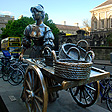COLLINS BARRACKS
Dublin’s Military and Decorative Arts Museum
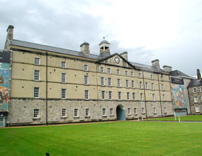 The Collins Barracks is listed in the Guinness World Record Book as
the oldest inhabited army barracks in Europe until being turned into
a national
museum. Originally just called The Barracks, since first built in 1702
under England’s Queen Anne, a beautifully restored design by 17th
Century architect Thomas Burgh, who also was responsible for the Trinity
College “old” Library where the Book of Kells are now on display
(see Trinity Library Book of Kells).
The site was intended to be an town manor for the Duke of Ormande, but
an army barracks seemed more necessary
for the crown. The Barracks to the west of old Dublin were the main headquarters
of the British forces in Ireland. It was from the Royal Barracks of Dublin
that the solders of English monarchs maintained
The Collins Barracks is listed in the Guinness World Record Book as
the oldest inhabited army barracks in Europe until being turned into
a national
museum. Originally just called The Barracks, since first built in 1702
under England’s Queen Anne, a beautifully restored design by 17th
Century architect Thomas Burgh, who also was responsible for the Trinity
College “old” Library where the Book of Kells are now on display
(see Trinity Library Book of Kells).
The site was intended to be an town manor for the Duke of Ormande, but
an army barracks seemed more necessary
for the crown. The Barracks to the west of old Dublin were the main headquarters
of the British forces in Ireland. It was from the Royal Barracks of Dublin
that the solders of English monarchs maintained 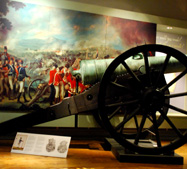 control over Ireland until
the Anglo-Irish Treaty of 1921 when the barracks were handed over to the
forces of the brief Irish Free State. The barracks were renamed the Collins
Barracks in 1922 after Irish revolutionary leader Michael Collins, then
head of the provisional government’s garrison based at the barracks
was killed in a shootout near Cork in an ambush by hardline Republicans
opposed to the treaty that would separate protestant Northern Ireland from
Catholic Ireland. The last battalion of the Irish 5th Infantry vacated
the Collins Barracks in 1997. Some visitors to Dublin leave the Collins
Barracks Museum off their must-see list, because it seems like chairs and
glassware, but is actually three museums in one, all for free.
control over Ireland until
the Anglo-Irish Treaty of 1921 when the barracks were handed over to the
forces of the brief Irish Free State. The barracks were renamed the Collins
Barracks in 1922 after Irish revolutionary leader Michael Collins, then
head of the provisional government’s garrison based at the barracks
was killed in a shootout near Cork in an ambush by hardline Republicans
opposed to the treaty that would separate protestant Northern Ireland from
Catholic Ireland. The last battalion of the Irish 5th Infantry vacated
the Collins Barracks in 1997. Some visitors to Dublin leave the Collins
Barracks Museum off their must-see list, because it seems like chairs and
glassware, but is actually three museums in one, all for free.
Decorative Arts History
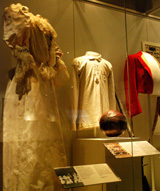 The Collins Barracks consisting of a collection of buildings around an
open central square is now home to the Decorative Arts and History section
of the Irish National Museum. The museum contains exhibits of Irish ceramics
and silverware, Irish Country and Period furniture, folk costumes, the
armor gauntlets worn by King William from the winning side of the battle
of Boyne (see Malahide
Castle), and an exhibit of fashion
through the ages. A variety of temporary exhibits show at the museum on
rotation.
The Collins Barracks consisting of a collection of buildings around an
open central square is now home to the Decorative Arts and History section
of the Irish National Museum. The museum contains exhibits of Irish ceramics
and silverware, Irish Country and Period furniture, folk costumes, the
armor gauntlets worn by King William from the winning side of the battle
of Boyne (see Malahide
Castle), and an exhibit of fashion
through the ages. A variety of temporary exhibits show at the museum on
rotation.
Natural History – The Dead Zoo
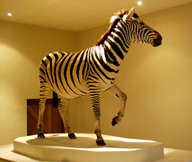 Just inside the entrance off the inner courtyard cobblestones where boots
once clomped on parade, a new exhibit from the natural history section
called The Dead Zoo, filling the space left by the closure of one of the
buildings for renovation work, offers the curious chance to see wild animals
of the world, from giraffes to badgers and zebras, a stuffed animal menagerie
like a visiting a real zoo without the feeding times. Fierce creatures
in glass
rather
than
iron
cages, and dinosaur bones kids will get a kick out of.
Just inside the entrance off the inner courtyard cobblestones where boots
once clomped on parade, a new exhibit from the natural history section
called The Dead Zoo, filling the space left by the closure of one of the
buildings for renovation work, offers the curious chance to see wild animals
of the world, from giraffes to badgers and zebras, a stuffed animal menagerie
like a visiting a real zoo without the feeding times. Fierce creatures
in glass
rather
than
iron
cages, and dinosaur bones kids will get a kick out of. Military History
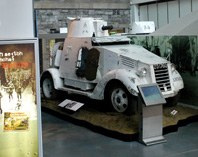 Two
wings of the Collins Barracks covering 8 galleries are devoted to Irish
Military History,with exhibits of weapons, uniforms and memorabilia, presenting
the story of Ireland’s soldiers from 1550 to current times in an
exhibition called “Soldiers and Chiefs” using original artifacts,
letters, replicas and interactive displays to examine the affect of soldiering
and war on the lives of Irish people and Irish soldiers nicknamed the “The
Wild Geese” in world conflicts from WWII to the U.N. forces, as well
as the lesser known Irish participation in America’s own Civil War
fighting on the Confederate side, even though a grandson of Ireland, Ulysses
S. Grant led the northern cause. A new exhibition called “The Easter
Rising: Understanding 1916” explores the Irish Revolution and its
decade of violence between 1913 and 1923, from the Dublin Lockout, through
the Easter Rising to the end of the Irish Civil War. Weapons on display
range from rifles, early hand bomb grenades to armored cars.
Two
wings of the Collins Barracks covering 8 galleries are devoted to Irish
Military History,with exhibits of weapons, uniforms and memorabilia, presenting
the story of Ireland’s soldiers from 1550 to current times in an
exhibition called “Soldiers and Chiefs” using original artifacts,
letters, replicas and interactive displays to examine the affect of soldiering
and war on the lives of Irish people and Irish soldiers nicknamed the “The
Wild Geese” in world conflicts from WWII to the U.N. forces, as well
as the lesser known Irish participation in America’s own Civil War
fighting on the Confederate side, even though a grandson of Ireland, Ulysses
S. Grant led the northern cause. A new exhibition called “The Easter
Rising: Understanding 1916” explores the Irish Revolution and its
decade of violence between 1913 and 1923, from the Dublin Lockout, through
the Easter Rising to the end of the Irish Civil War. Weapons on display
range from rifles, early hand bomb grenades to armored cars.The Collins Barracks is on Benburb Street, the main boulevard west from central Dublin, near the revitalized Smithfield district, a few blocks from the Jameson Distillery (see Jameson Distillery Tour) and north of the Quay across the James Joyce Bridge from the the Guinness Storehouse on St. James Street (see Guinness Storehouse). The Collins Barracks is a stop on the city bus line and the Tram, as well as the On-Off Dublin Tour Busses, or about a 15 minute walk from Dublin Castle. Entrance is free to all the Ireland National Museums. © Bargain Travel Europe
Find best hotel and travel deals in Dublin
Web Info
National
Museums of Ireland
These articles are copyrighted and the sole property of Bargain Travel Europe and WLPV, LLC. and may not be copied or reprinted without permission.
SEE ALSO:
DUBLINIA - VIKING WORLD & STRONGBOW
TEMPLE BAR - BOHEMIAN PUBS & TRADITIONAL MUSIC
ST. COLUMB'S CATHEDRAL - LONDONDERRY
DUBLIN CITY HALL - STORY OF THE CAPITAL
WAR MEMORIAL & HOMEFRONT - BELFAST
WATERFORD
CRYSTAL - FACTORY TOUR

